Holmes Institute HI6006: Competitive Strategy Essay on Strategy Tools
VerifiedAdded on 2023/02/01
|11
|1819
|93
Essay
AI Summary
This essay provides a comprehensive analysis of key strategic tools used in competitive strategy. It begins with an introduction highlighting the importance of strategic tools in providing direction and outlining measurable goals. The essay delves into the SWOT analysis, explaining its framework for evaluating a company's competitive position and strategic planning, including strengths, weaknesses, opportunities, and threats. The PESTEL analysis is then examined, focusing on macro-environmental factors and their impact on organizations. The Ansoff Matrix is explored as a tool for strategic market planning, identifying revenue opportunities through product development and market expansion. Finally, the essay analyzes Porter's Five Forces model, which determines the intensity of competition in an industry. Each tool is explained in detail, with practical applications and examples, demonstrating their significance in improving business operations and achieving success in a competitive environment. The essay references relevant literature to support its arguments and conclusions.
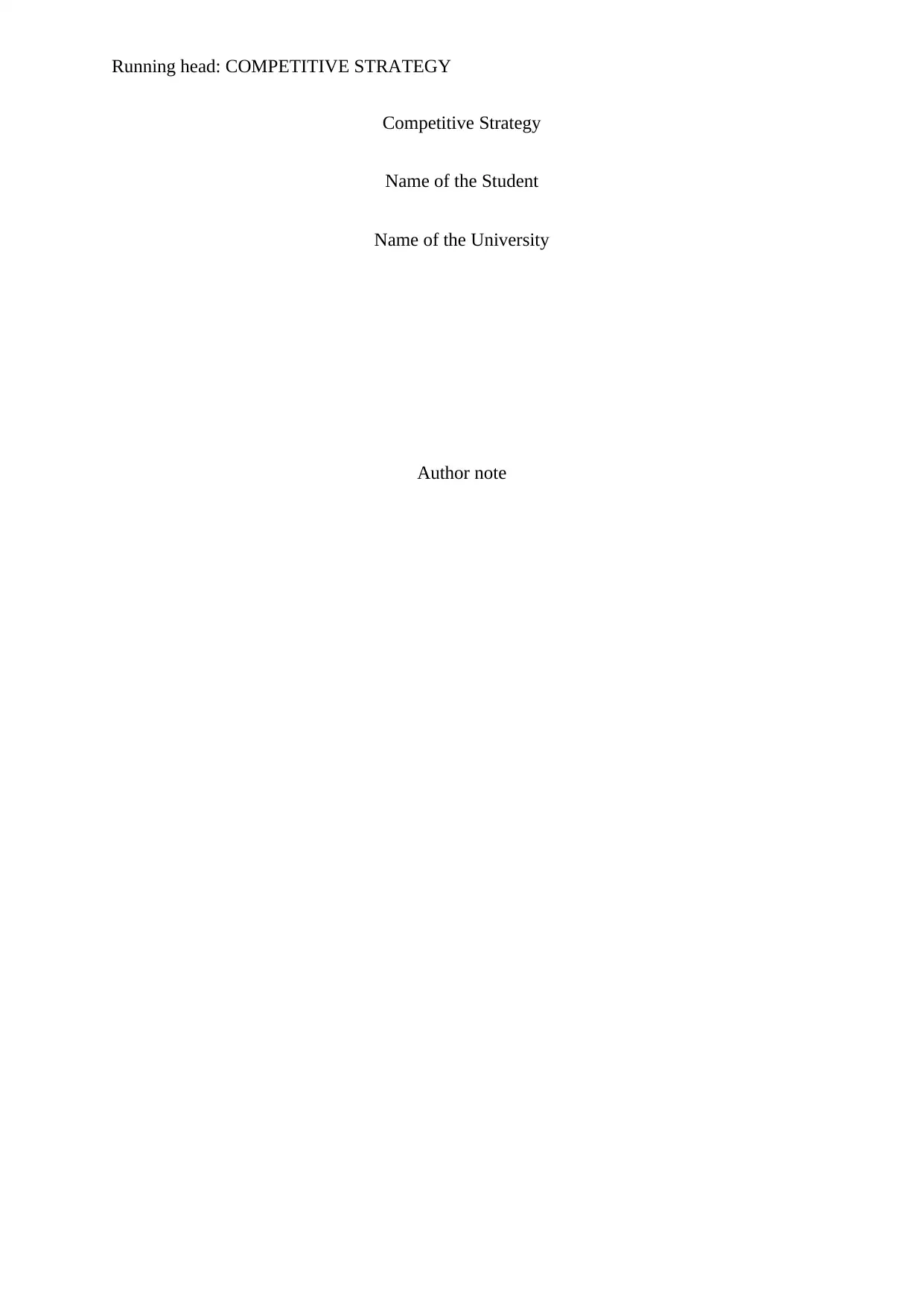
Running head: COMPETITIVE STRATEGY
Competitive Strategy
Name of the Student
Name of the University
Author note
Competitive Strategy
Name of the Student
Name of the University
Author note
Paraphrase This Document
Need a fresh take? Get an instant paraphrase of this document with our AI Paraphraser
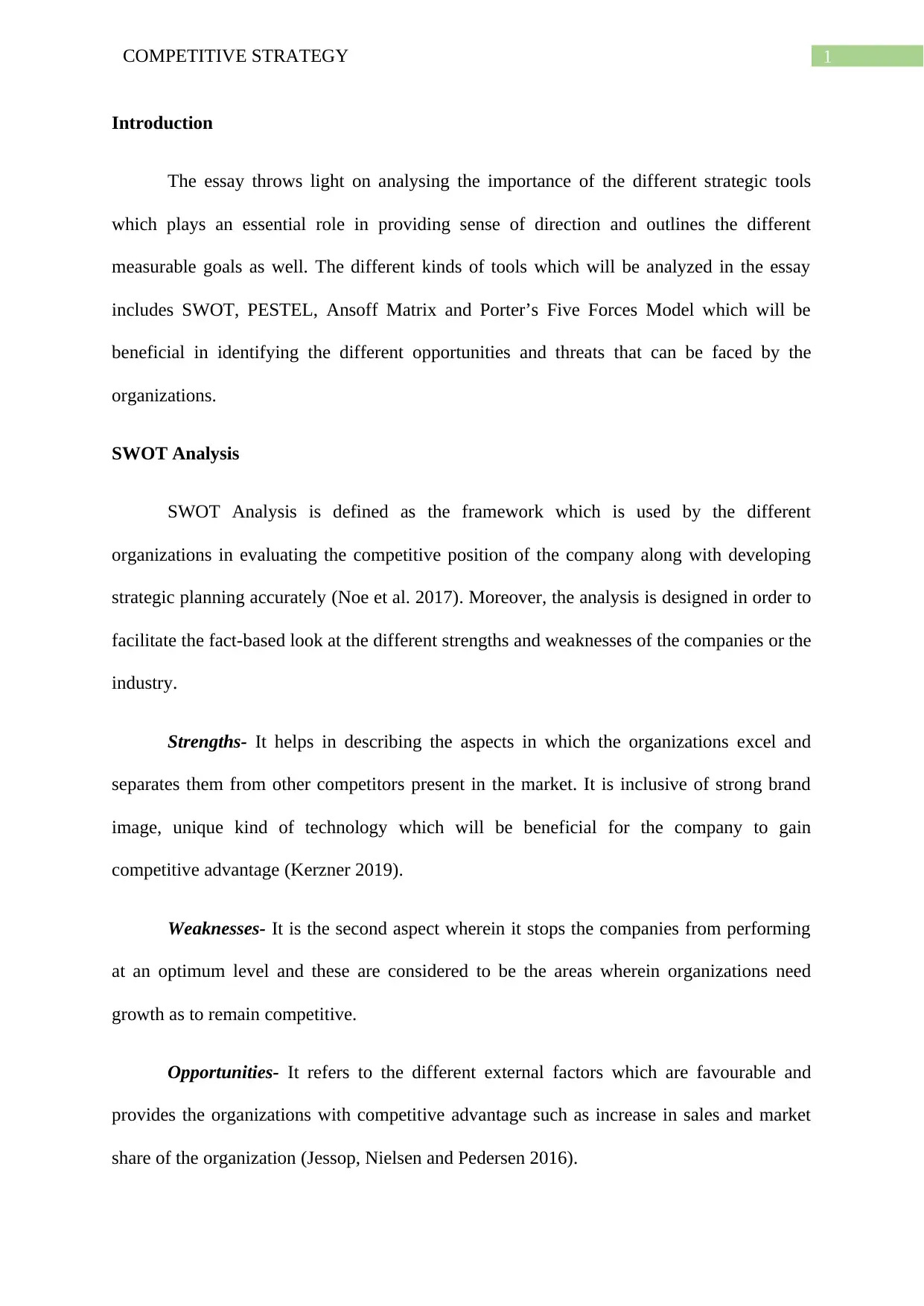
1COMPETITIVE STRATEGY
Introduction
The essay throws light on analysing the importance of the different strategic tools
which plays an essential role in providing sense of direction and outlines the different
measurable goals as well. The different kinds of tools which will be analyzed in the essay
includes SWOT, PESTEL, Ansoff Matrix and Porter’s Five Forces Model which will be
beneficial in identifying the different opportunities and threats that can be faced by the
organizations.
SWOT Analysis
SWOT Analysis is defined as the framework which is used by the different
organizations in evaluating the competitive position of the company along with developing
strategic planning accurately (Noe et al. 2017). Moreover, the analysis is designed in order to
facilitate the fact-based look at the different strengths and weaknesses of the companies or the
industry.
Strengths- It helps in describing the aspects in which the organizations excel and
separates them from other competitors present in the market. It is inclusive of strong brand
image, unique kind of technology which will be beneficial for the company to gain
competitive advantage (Kerzner 2019).
Weaknesses- It is the second aspect wherein it stops the companies from performing
at an optimum level and these are considered to be the areas wherein organizations need
growth as to remain competitive.
Opportunities- It refers to the different external factors which are favourable and
provides the organizations with competitive advantage such as increase in sales and market
share of the organization (Jessop, Nielsen and Pedersen 2016).
Introduction
The essay throws light on analysing the importance of the different strategic tools
which plays an essential role in providing sense of direction and outlines the different
measurable goals as well. The different kinds of tools which will be analyzed in the essay
includes SWOT, PESTEL, Ansoff Matrix and Porter’s Five Forces Model which will be
beneficial in identifying the different opportunities and threats that can be faced by the
organizations.
SWOT Analysis
SWOT Analysis is defined as the framework which is used by the different
organizations in evaluating the competitive position of the company along with developing
strategic planning accurately (Noe et al. 2017). Moreover, the analysis is designed in order to
facilitate the fact-based look at the different strengths and weaknesses of the companies or the
industry.
Strengths- It helps in describing the aspects in which the organizations excel and
separates them from other competitors present in the market. It is inclusive of strong brand
image, unique kind of technology which will be beneficial for the company to gain
competitive advantage (Kerzner 2019).
Weaknesses- It is the second aspect wherein it stops the companies from performing
at an optimum level and these are considered to be the areas wherein organizations need
growth as to remain competitive.
Opportunities- It refers to the different external factors which are favourable and
provides the organizations with competitive advantage such as increase in sales and market
share of the organization (Jessop, Nielsen and Pedersen 2016).
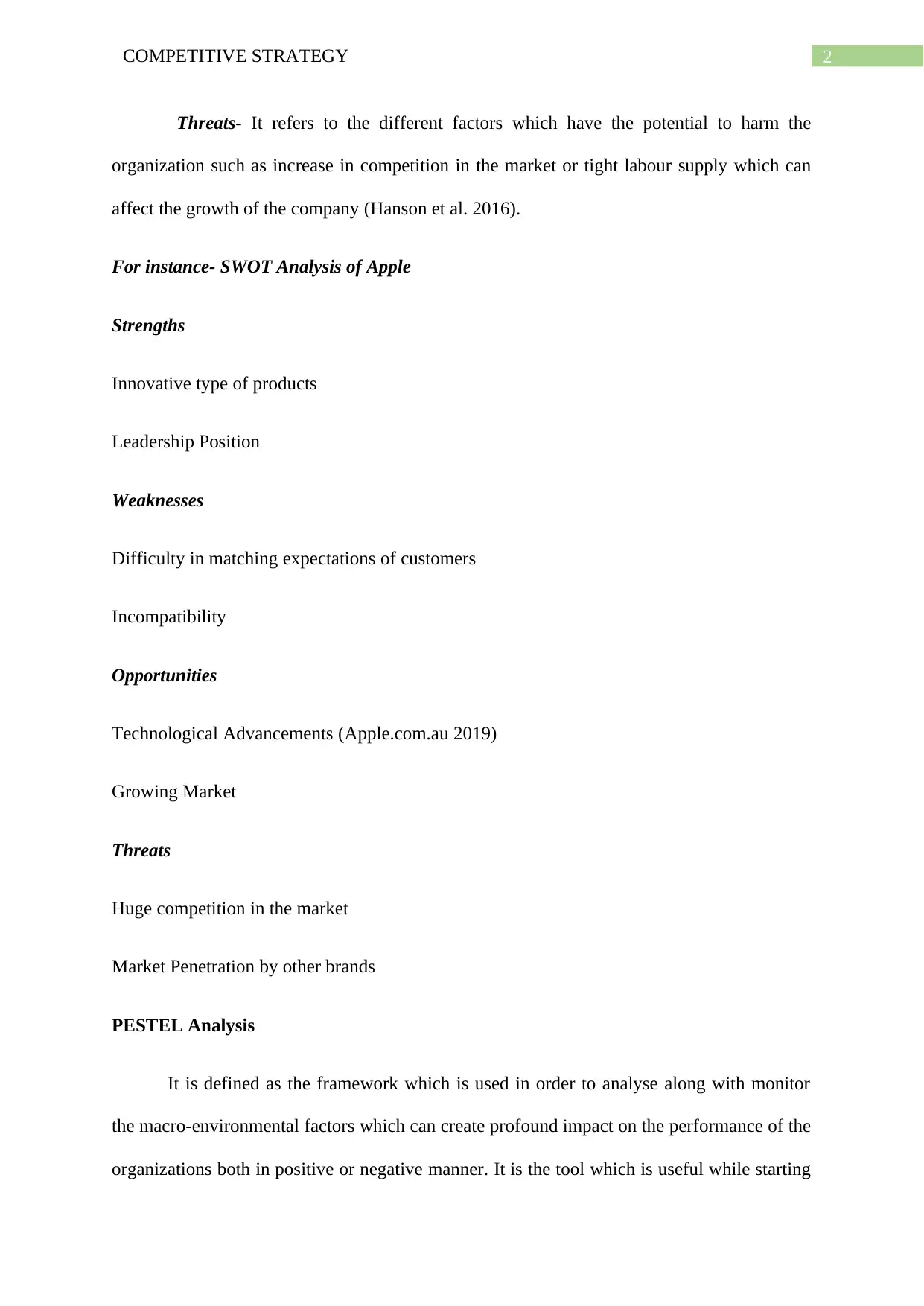
2COMPETITIVE STRATEGY
Threats- It refers to the different factors which have the potential to harm the
organization such as increase in competition in the market or tight labour supply which can
affect the growth of the company (Hanson et al. 2016).
For instance- SWOT Analysis of Apple
Strengths
Innovative type of products
Leadership Position
Weaknesses
Difficulty in matching expectations of customers
Incompatibility
Opportunities
Technological Advancements (Apple.com.au 2019)
Growing Market
Threats
Huge competition in the market
Market Penetration by other brands
PESTEL Analysis
It is defined as the framework which is used in order to analyse along with monitor
the macro-environmental factors which can create profound impact on the performance of the
organizations both in positive or negative manner. It is the tool which is useful while starting
Threats- It refers to the different factors which have the potential to harm the
organization such as increase in competition in the market or tight labour supply which can
affect the growth of the company (Hanson et al. 2016).
For instance- SWOT Analysis of Apple
Strengths
Innovative type of products
Leadership Position
Weaknesses
Difficulty in matching expectations of customers
Incompatibility
Opportunities
Technological Advancements (Apple.com.au 2019)
Growing Market
Threats
Huge competition in the market
Market Penetration by other brands
PESTEL Analysis
It is defined as the framework which is used in order to analyse along with monitor
the macro-environmental factors which can create profound impact on the performance of the
organizations both in positive or negative manner. It is the tool which is useful while starting
⊘ This is a preview!⊘
Do you want full access?
Subscribe today to unlock all pages.

Trusted by 1+ million students worldwide
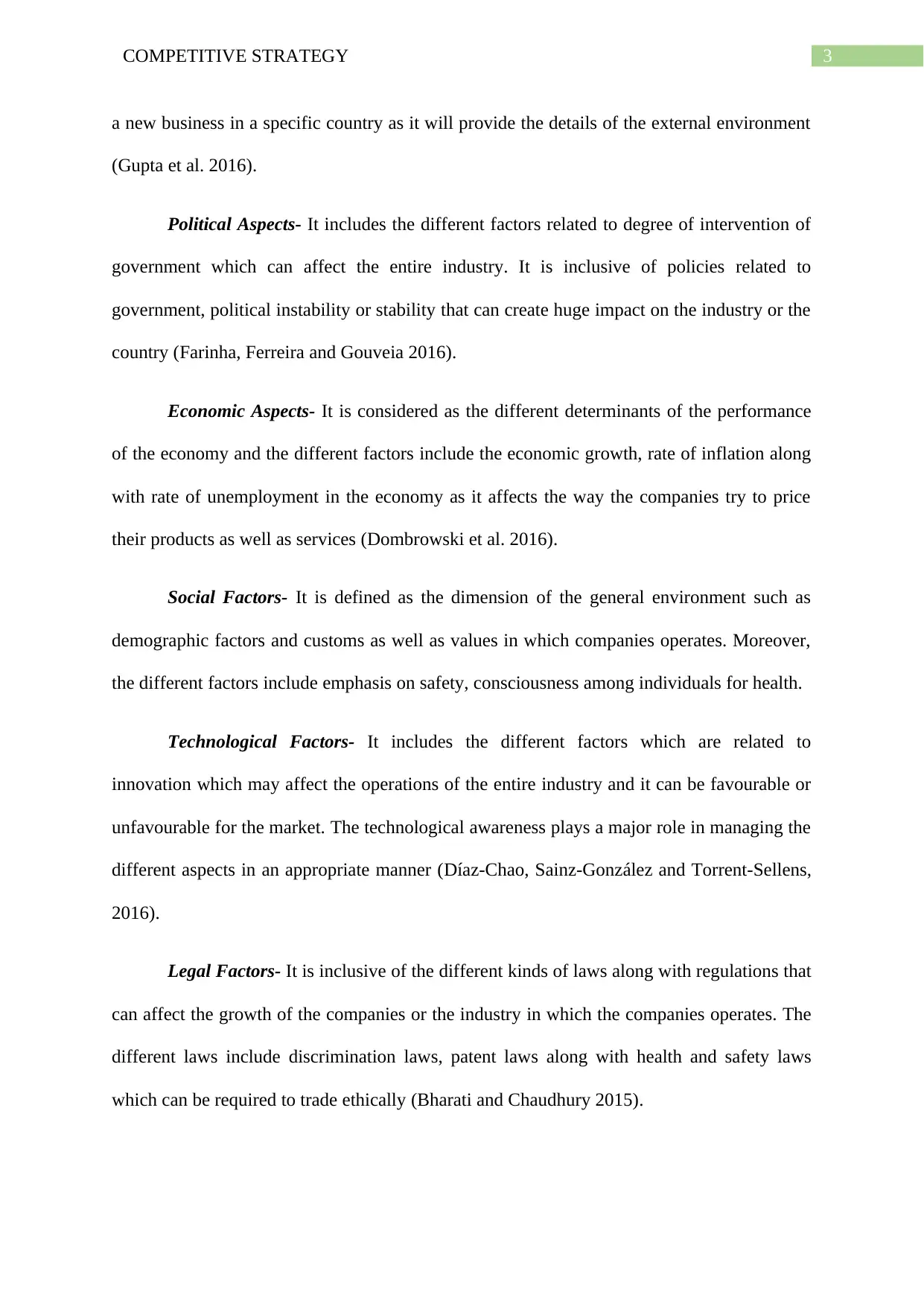
3COMPETITIVE STRATEGY
a new business in a specific country as it will provide the details of the external environment
(Gupta et al. 2016).
Political Aspects- It includes the different factors related to degree of intervention of
government which can affect the entire industry. It is inclusive of policies related to
government, political instability or stability that can create huge impact on the industry or the
country (Farinha, Ferreira and Gouveia 2016).
Economic Aspects- It is considered as the different determinants of the performance
of the economy and the different factors include the economic growth, rate of inflation along
with rate of unemployment in the economy as it affects the way the companies try to price
their products as well as services (Dombrowski et al. 2016).
Social Factors- It is defined as the dimension of the general environment such as
demographic factors and customs as well as values in which companies operates. Moreover,
the different factors include emphasis on safety, consciousness among individuals for health.
Technological Factors- It includes the different factors which are related to
innovation which may affect the operations of the entire industry and it can be favourable or
unfavourable for the market. The technological awareness plays a major role in managing the
different aspects in an appropriate manner (Díaz-Chao, Sainz-González and Torrent-Sellens,
2016).
Legal Factors- It is inclusive of the different kinds of laws along with regulations that
can affect the growth of the companies or the industry in which the companies operates. The
different laws include discrimination laws, patent laws along with health and safety laws
which can be required to trade ethically (Bharati and Chaudhury 2015).
a new business in a specific country as it will provide the details of the external environment
(Gupta et al. 2016).
Political Aspects- It includes the different factors related to degree of intervention of
government which can affect the entire industry. It is inclusive of policies related to
government, political instability or stability that can create huge impact on the industry or the
country (Farinha, Ferreira and Gouveia 2016).
Economic Aspects- It is considered as the different determinants of the performance
of the economy and the different factors include the economic growth, rate of inflation along
with rate of unemployment in the economy as it affects the way the companies try to price
their products as well as services (Dombrowski et al. 2016).
Social Factors- It is defined as the dimension of the general environment such as
demographic factors and customs as well as values in which companies operates. Moreover,
the different factors include emphasis on safety, consciousness among individuals for health.
Technological Factors- It includes the different factors which are related to
innovation which may affect the operations of the entire industry and it can be favourable or
unfavourable for the market. The technological awareness plays a major role in managing the
different aspects in an appropriate manner (Díaz-Chao, Sainz-González and Torrent-Sellens,
2016).
Legal Factors- It is inclusive of the different kinds of laws along with regulations that
can affect the growth of the companies or the industry in which the companies operates. The
different laws include discrimination laws, patent laws along with health and safety laws
which can be required to trade ethically (Bharati and Chaudhury 2015).
Paraphrase This Document
Need a fresh take? Get an instant paraphrase of this document with our AI Paraphraser
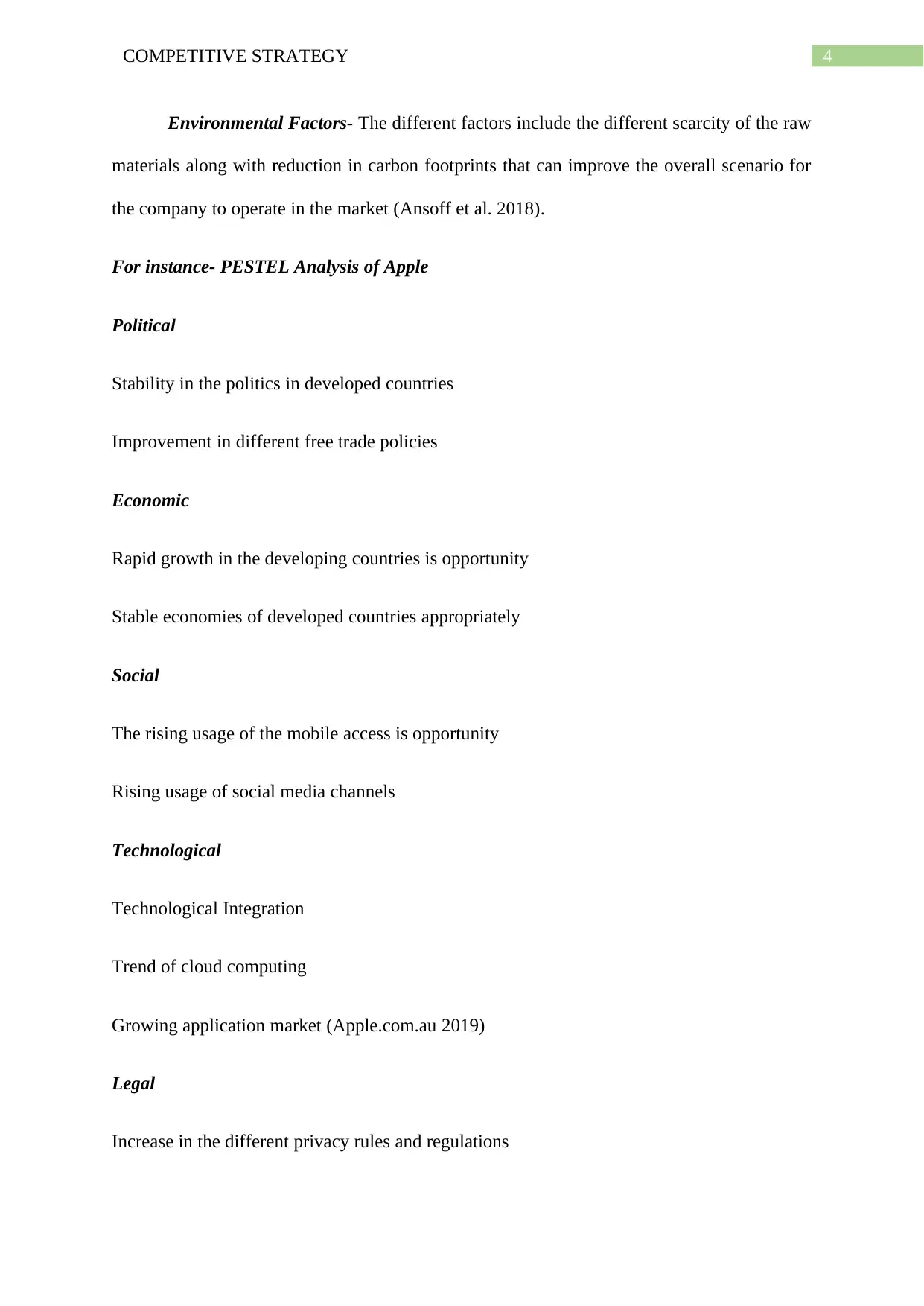
4COMPETITIVE STRATEGY
Environmental Factors- The different factors include the different scarcity of the raw
materials along with reduction in carbon footprints that can improve the overall scenario for
the company to operate in the market (Ansoff et al. 2018).
For instance- PESTEL Analysis of Apple
Political
Stability in the politics in developed countries
Improvement in different free trade policies
Economic
Rapid growth in the developing countries is opportunity
Stable economies of developed countries appropriately
Social
The rising usage of the mobile access is opportunity
Rising usage of social media channels
Technological
Technological Integration
Trend of cloud computing
Growing application market (Apple.com.au 2019)
Legal
Increase in the different privacy rules and regulations
Environmental Factors- The different factors include the different scarcity of the raw
materials along with reduction in carbon footprints that can improve the overall scenario for
the company to operate in the market (Ansoff et al. 2018).
For instance- PESTEL Analysis of Apple
Political
Stability in the politics in developed countries
Improvement in different free trade policies
Economic
Rapid growth in the developing countries is opportunity
Stable economies of developed countries appropriately
Social
The rising usage of the mobile access is opportunity
Rising usage of social media channels
Technological
Technological Integration
Trend of cloud computing
Growing application market (Apple.com.au 2019)
Legal
Increase in the different privacy rules and regulations

5COMPETITIVE STRATEGY
Increase in threat in telecom industry due to regulations
Environmental
Trend of sustainability in business
Trends of labour trend
Ansoff Matrix
It is defined as the tool and model which is essential for the strategic market planning
which can be applied to identify the different kinds of opportunities which will be acting as
the revenue for the business through proper development of new products along with services
or tapping into the different new markets (Ansoff et al. 2018).
Market Penetration- It is inclusive wherein the main focus is on increasing the sales
of the existing products to the existing market
Market Development- It mainly focuses on entering in the new market through proper
utilization of the existing products
Product Development- It is inclusive of the different aspects wherein the main focus
on introducing the different new products to the existing markets (Ansoff et al. 2018)
Diversification- It is mainly focusing on entering a new market with the proper
introduction of the new products
For instance- Ansoff Matrix of Apple
Market Development- It is adopted by Apple Company as the major growth strategy
and the main aspect is the long-term growth perspective of the company.
Increase in threat in telecom industry due to regulations
Environmental
Trend of sustainability in business
Trends of labour trend
Ansoff Matrix
It is defined as the tool and model which is essential for the strategic market planning
which can be applied to identify the different kinds of opportunities which will be acting as
the revenue for the business through proper development of new products along with services
or tapping into the different new markets (Ansoff et al. 2018).
Market Penetration- It is inclusive wherein the main focus is on increasing the sales
of the existing products to the existing market
Market Development- It mainly focuses on entering in the new market through proper
utilization of the existing products
Product Development- It is inclusive of the different aspects wherein the main focus
on introducing the different new products to the existing markets (Ansoff et al. 2018)
Diversification- It is mainly focusing on entering a new market with the proper
introduction of the new products
For instance- Ansoff Matrix of Apple
Market Development- It is adopted by Apple Company as the major growth strategy
and the main aspect is the long-term growth perspective of the company.
⊘ This is a preview!⊘
Do you want full access?
Subscribe today to unlock all pages.

Trusted by 1+ million students worldwide
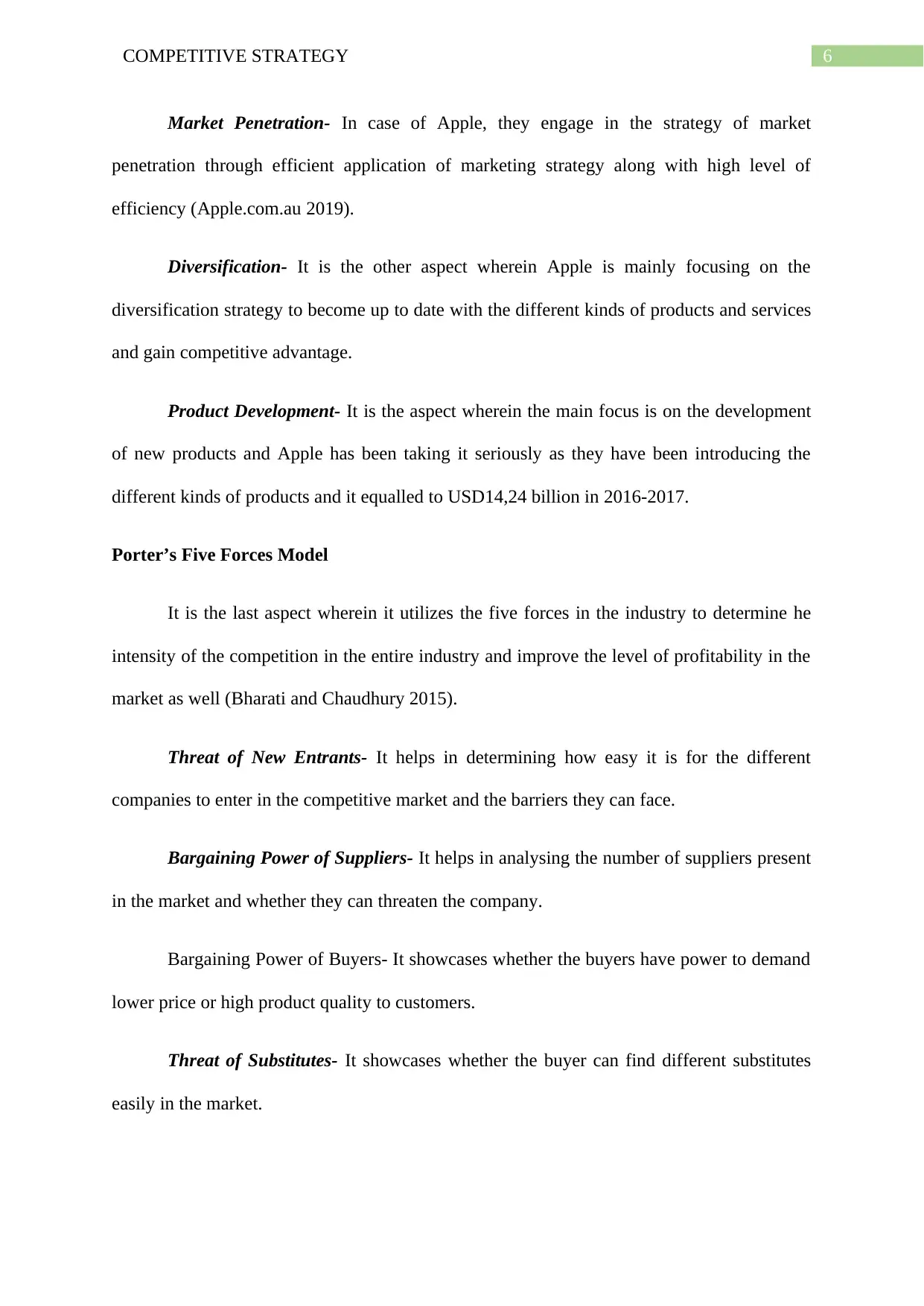
6COMPETITIVE STRATEGY
Market Penetration- In case of Apple, they engage in the strategy of market
penetration through efficient application of marketing strategy along with high level of
efficiency (Apple.com.au 2019).
Diversification- It is the other aspect wherein Apple is mainly focusing on the
diversification strategy to become up to date with the different kinds of products and services
and gain competitive advantage.
Product Development- It is the aspect wherein the main focus is on the development
of new products and Apple has been taking it seriously as they have been introducing the
different kinds of products and it equalled to USD14,24 billion in 2016-2017.
Porter’s Five Forces Model
It is the last aspect wherein it utilizes the five forces in the industry to determine he
intensity of the competition in the entire industry and improve the level of profitability in the
market as well (Bharati and Chaudhury 2015).
Threat of New Entrants- It helps in determining how easy it is for the different
companies to enter in the competitive market and the barriers they can face.
Bargaining Power of Suppliers- It helps in analysing the number of suppliers present
in the market and whether they can threaten the company.
Bargaining Power of Buyers- It showcases whether the buyers have power to demand
lower price or high product quality to customers.
Threat of Substitutes- It showcases whether the buyer can find different substitutes
easily in the market.
Market Penetration- In case of Apple, they engage in the strategy of market
penetration through efficient application of marketing strategy along with high level of
efficiency (Apple.com.au 2019).
Diversification- It is the other aspect wherein Apple is mainly focusing on the
diversification strategy to become up to date with the different kinds of products and services
and gain competitive advantage.
Product Development- It is the aspect wherein the main focus is on the development
of new products and Apple has been taking it seriously as they have been introducing the
different kinds of products and it equalled to USD14,24 billion in 2016-2017.
Porter’s Five Forces Model
It is the last aspect wherein it utilizes the five forces in the industry to determine he
intensity of the competition in the entire industry and improve the level of profitability in the
market as well (Bharati and Chaudhury 2015).
Threat of New Entrants- It helps in determining how easy it is for the different
companies to enter in the competitive market and the barriers they can face.
Bargaining Power of Suppliers- It helps in analysing the number of suppliers present
in the market and whether they can threaten the company.
Bargaining Power of Buyers- It showcases whether the buyers have power to demand
lower price or high product quality to customers.
Threat of Substitutes- It showcases whether the buyer can find different substitutes
easily in the market.
Paraphrase This Document
Need a fresh take? Get an instant paraphrase of this document with our AI Paraphraser
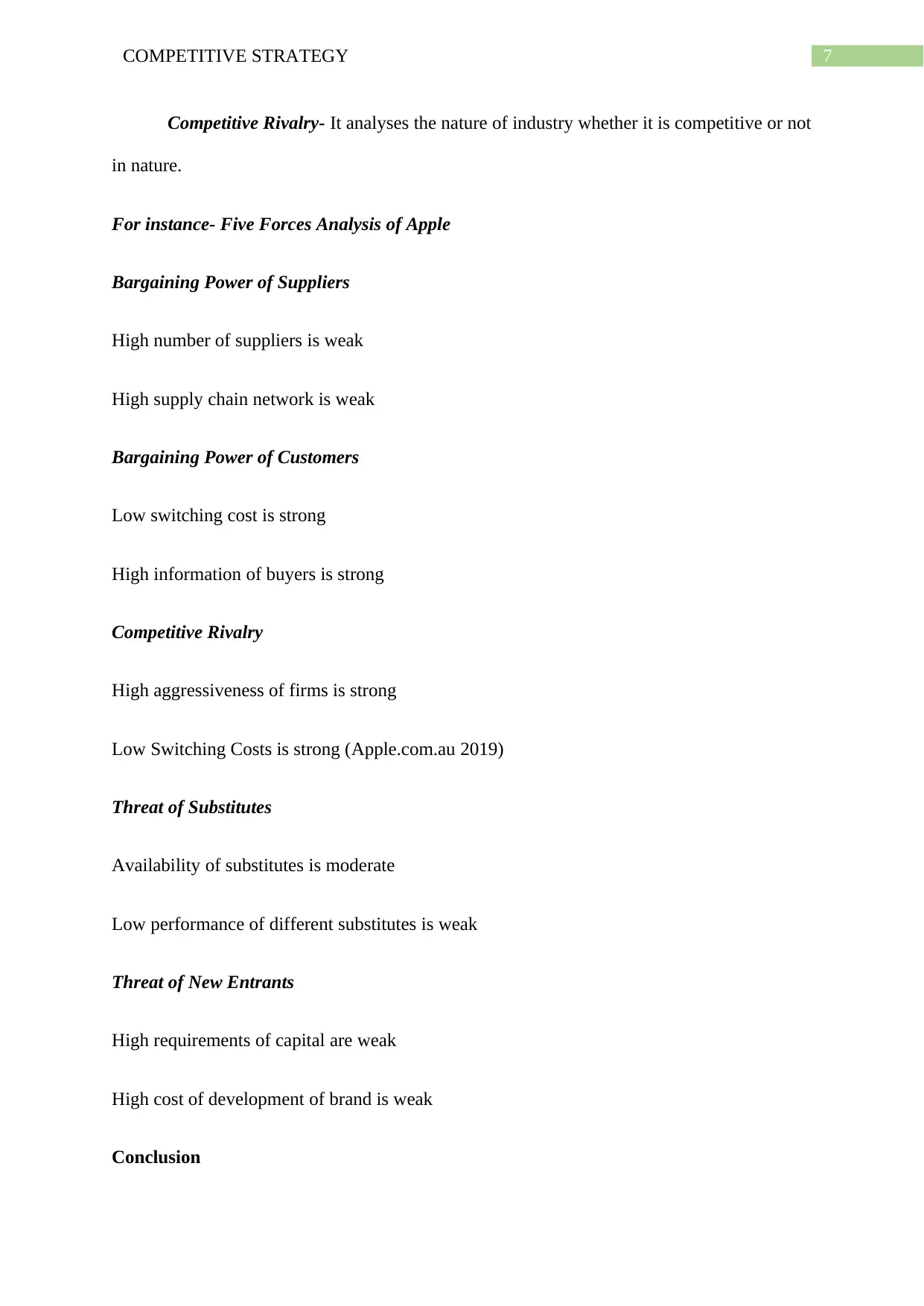
7COMPETITIVE STRATEGY
Competitive Rivalry- It analyses the nature of industry whether it is competitive or not
in nature.
For instance- Five Forces Analysis of Apple
Bargaining Power of Suppliers
High number of suppliers is weak
High supply chain network is weak
Bargaining Power of Customers
Low switching cost is strong
High information of buyers is strong
Competitive Rivalry
High aggressiveness of firms is strong
Low Switching Costs is strong (Apple.com.au 2019)
Threat of Substitutes
Availability of substitutes is moderate
Low performance of different substitutes is weak
Threat of New Entrants
High requirements of capital are weak
High cost of development of brand is weak
Conclusion
Competitive Rivalry- It analyses the nature of industry whether it is competitive or not
in nature.
For instance- Five Forces Analysis of Apple
Bargaining Power of Suppliers
High number of suppliers is weak
High supply chain network is weak
Bargaining Power of Customers
Low switching cost is strong
High information of buyers is strong
Competitive Rivalry
High aggressiveness of firms is strong
Low Switching Costs is strong (Apple.com.au 2019)
Threat of Substitutes
Availability of substitutes is moderate
Low performance of different substitutes is weak
Threat of New Entrants
High requirements of capital are weak
High cost of development of brand is weak
Conclusion

8COMPETITIVE STRATEGY
Therefore, it can be concluded that strategic development tool plays a beneficial role
in improving the business operations and operate successfully in the competitive business
environment.
Therefore, it can be concluded that strategic development tool plays a beneficial role
in improving the business operations and operate successfully in the competitive business
environment.
⊘ This is a preview!⊘
Do you want full access?
Subscribe today to unlock all pages.

Trusted by 1+ million students worldwide

9COMPETITIVE STRATEGY
References
Ansoff, H.I., Kipley, D., Lewis, A.O., Helm-Stevens, R. and Ansoff, R., 2018. Implanting
strategic management. Springer.
Apple.com.au 2019 Apple (online) Retrieved from https://www.apple.com/au/ [Accessed on
25th April 2019]
Bharati, P. and Chaudhury, A., 2015. SMEs and competitiveness: The role of information
systems. Bharati, P. and Chaudhury, A.(2009),“SMEs and Competitiveness: The Role of
Information Systems”, International Journal of E-Business Research, 5(1).
Díaz-Chao, Á., Sainz-González, J. and Torrent-Sellens, J., 2016. The competitiveness of
small network-firm: A practical tool. Journal of Business Research, 69(5), pp.1769-1774.
Dombrowski, U., Intra, C., Zahn, T. and Krenkel, P., 2016. Manufacturing strategy–a
neglected success factor for improving competitiveness. Procedia CIRP, 41, pp.9-14.
Farinha, L., Ferreira, J. and Gouveia, B., 2016. Networks of innovation and competitiveness:
a triple helix case study. Journal of the Knowledge Economy, 7(1), pp.259-275.
Gupta, S., Malhotra, N.K., Czinkota, M. and Foroudi, P., 2016. Marketing innovation: A
consequence of competitiveness. Journal of Business Research, 69(12), pp.5671-5681.
Hanson, D., Hitt, M.A., Ireland, R.D. and Hoskisson, R.E., 2016. Strategic management:
Competitiveness and globalisation. Cengage AU.
Jessop, B., Nielsen, K. and Pedersen, O.K., 2016. Structural competitiveness and strategic
capacities: rethinking the state and international capital. Institutional Change: Theory and
Empirical Findings: Theory and Empirical Findings, p.227.
References
Ansoff, H.I., Kipley, D., Lewis, A.O., Helm-Stevens, R. and Ansoff, R., 2018. Implanting
strategic management. Springer.
Apple.com.au 2019 Apple (online) Retrieved from https://www.apple.com/au/ [Accessed on
25th April 2019]
Bharati, P. and Chaudhury, A., 2015. SMEs and competitiveness: The role of information
systems. Bharati, P. and Chaudhury, A.(2009),“SMEs and Competitiveness: The Role of
Information Systems”, International Journal of E-Business Research, 5(1).
Díaz-Chao, Á., Sainz-González, J. and Torrent-Sellens, J., 2016. The competitiveness of
small network-firm: A practical tool. Journal of Business Research, 69(5), pp.1769-1774.
Dombrowski, U., Intra, C., Zahn, T. and Krenkel, P., 2016. Manufacturing strategy–a
neglected success factor for improving competitiveness. Procedia CIRP, 41, pp.9-14.
Farinha, L., Ferreira, J. and Gouveia, B., 2016. Networks of innovation and competitiveness:
a triple helix case study. Journal of the Knowledge Economy, 7(1), pp.259-275.
Gupta, S., Malhotra, N.K., Czinkota, M. and Foroudi, P., 2016. Marketing innovation: A
consequence of competitiveness. Journal of Business Research, 69(12), pp.5671-5681.
Hanson, D., Hitt, M.A., Ireland, R.D. and Hoskisson, R.E., 2016. Strategic management:
Competitiveness and globalisation. Cengage AU.
Jessop, B., Nielsen, K. and Pedersen, O.K., 2016. Structural competitiveness and strategic
capacities: rethinking the state and international capital. Institutional Change: Theory and
Empirical Findings: Theory and Empirical Findings, p.227.
Paraphrase This Document
Need a fresh take? Get an instant paraphrase of this document with our AI Paraphraser
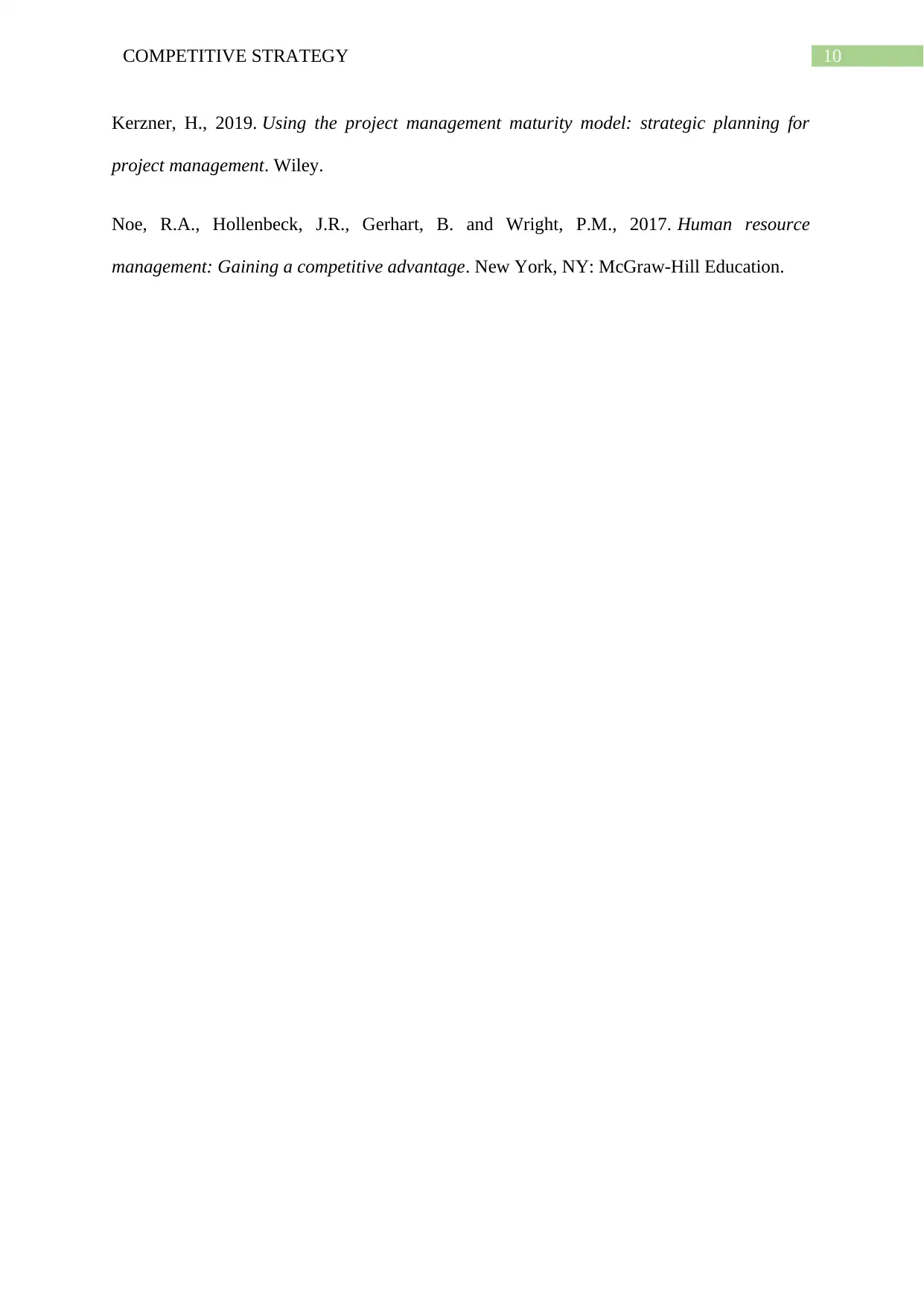
10COMPETITIVE STRATEGY
Kerzner, H., 2019. Using the project management maturity model: strategic planning for
project management. Wiley.
Noe, R.A., Hollenbeck, J.R., Gerhart, B. and Wright, P.M., 2017. Human resource
management: Gaining a competitive advantage. New York, NY: McGraw-Hill Education.
Kerzner, H., 2019. Using the project management maturity model: strategic planning for
project management. Wiley.
Noe, R.A., Hollenbeck, J.R., Gerhart, B. and Wright, P.M., 2017. Human resource
management: Gaining a competitive advantage. New York, NY: McGraw-Hill Education.
1 out of 11
Related Documents
Your All-in-One AI-Powered Toolkit for Academic Success.
+13062052269
info@desklib.com
Available 24*7 on WhatsApp / Email
![[object Object]](/_next/static/media/star-bottom.7253800d.svg)
Unlock your academic potential
Copyright © 2020–2025 A2Z Services. All Rights Reserved. Developed and managed by ZUCOL.





